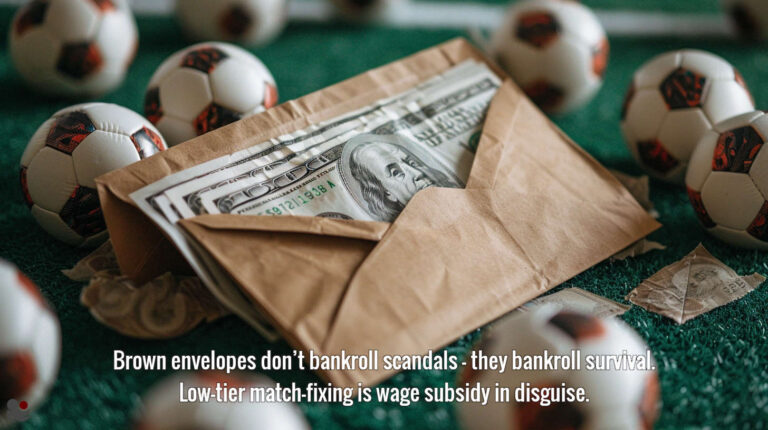
This article moves away from betting on individual teams, and pushes strategic thinking further up the knowledge ladder.
The method described below explains how to use our HDA simulation tables for recognising profitable 1×2 betting strategies and building a portfolio from a selection of major European leagues.
Profitable betting on football is about compiling successful portfolios and understanding the underlying market economics.
The following analysis portrays just one successful scheme in detail – Have fun learning about market behaviour and deriving a betting system from it! 🙂
Understanding the Betting Market
It is impossible to predict with total accuracy the outcome of one particular match; however, it is possible to identify and use historical distributions of data to judge the future in general.
If you do not know what the term ‘distribution’ means, check out this article for an introduction:
Goal Distribution Comparison – EPL, Bundesliga, Ligue 1, Eredivisie
However, understanding distributions, odds calculation and probabilities is only the first step.
The next step is to understand the market economics. Just in case you missed them here are two articles describing how the bookmaker market works:-
How do Bookmakers Tick? How & Why do They Set Their Odds as They do?
How Bookmakers’ Odds Match Public Opinion
The main message of these two articles:
- Bookmakers set odds based on a mixture of statistical probabilities and public opinion. Effectively, their odds match public opinion.
- Bookmakers do not speculate (gamble). Their priority is balancing the books.
Comprehending Market Economics to Elect a Strategy to Investigate Further
Remember your basic economics lessons in school or college which were about supply and demand.
Adapt this to the football betting market: In which situations will bookmakers reduce their prices (odds), and which prices will increase as a result? Which bets are traditionally the most popular?
The fact is the majority of punters prefer betting on favourites up to odds of 2.5. Just look at online odds comparison sites which show the percentage distribution of bets on a certain outcome. It is frequently above 60% on the favourite (independent from the offered odds), if not higher.
On the other hand, consumer demand for bets on the underdog is often much lower than the actual chance of it winning.
Bookmakers are aware of this market behaviour and try their best to predict trends, time the market, and choose the best outlets for their odds. Customer behaviour is well analysed and used to generate various marketing strategies aimed at balancing the books and boosting sales.
Therefore, for the bettor, it is safe to assume that many favourites will be under-priced to win, and draws and/or away wins will be over-priced to “make up and balance the book”.
For example, a traditionally strong team like Bayern Munich playing away will, of course, attract a good deal of punters betting on them to win rather than any weaker opponent playing at home. However, most punters are normally ignorant of the fact that even teams such as the mighty Bayern Munich win approximately just 50% of their away games.
In these game constellations bookmakers, simply by following market economics, have to reduce their prices for the (away) favourites massively and balance this by increasing the price of the less fancied home team.
Investigating Distributions: Profit/Loss Inflection Points
From what has been explained in the previous chapter it should now be obvious that favourites are often under-priced to win, and draws and/or away are frequently over-priced. Therefore, it should be possible to find a workable strategy using this knowledge.
Now comes some maths… hang in there! 🙂
In the last five seasons, a total of 1,900 matches were played in the English Premier League (EPL), of which, 46.74% finished in a home win:
 EPL: Full-time 1×2 distribution – Five seasons 2009-14
EPL: Full-time 1×2 distribution – Five seasons 2009-14The home team was priced the favourite in 1,351 of these matches (home odds lower than the away odds), and a total of 763 games did indeed end in a home win, equating to 56.48%.
 EPL: Favourite home wins – Five seasons 2009-14
EPL: Favourite home wins – Five seasons 2009-14The balance of 549 matches saw the home team priced as the underdog (home odds higher than the away odds). From these games, 125 finished in a home win for the underdog, equating to 22.77%.
 EPL: Underdog home wins – Five seasons 2009-14
EPL: Underdog home wins – Five seasons 2009-14Now convert these favourite and underdog win percentages into odds:
Home wins (Favourite): 56.48% = 1.77 [European odds]
Home wins (Underdog): 22.77% = 4.40 [European odds]
The above two odds are “inflection points”, the points on a curve at which the curvature or concavity changes from plus to minus or, from minus to plus. Translated into layman’s language… the pivot points along the profit/loss curve where profits turn to losses or, where losses turn to profits.
However, these are purely the mathematical inflection points and do not take market forces into consideration.
Therefore, please do not start betting on every favourite at home priced below 1.77 in the EPL, or on every underdog playing at home priced above 4.40. (Although following this simple strategy would have produced quite a profit!).








Dear Elena,
hope you’re doing well. I have the following somewhat interesting questions no one has asked before if I’m correct:
(1) The inflection Points of how many previous seasons in your opinion would be optimal to build your strategy on? You’ve mentioned previously that you think that 6 are too many.
(2) When the new season starts, do you discard the oldest season and include the Inflections of the last season?
Thank you for your valuable thoughts on that!
Florian
Hi Florian,
as I already said, 6 seasons are probably too many. There are too many changes in the format of the leagues, different teams competing, or now, this virus affecting the 1×2 performance. There is always something going on. Five seasons for the Inflection Point graphs proved to be ideal and it certainly shows trends. However, if you calculate individual matches then you can always check your calculations by using the last 25 matches (that is 1.5 years). Anything less it’s too little and statistically speaking, too much noise.
To your (2) question: Yes, when the new season starts you drop the oldest season and replace it with the season that just finished.
By the way, currently, the Cluster Tables seem to perform much more reliable than the HDAFU tables. Playing without crowd hasn’t so much affected the total goal count but it somewhat seems that there are many more away teams currently winning than previously. Regarding odds and distribution, Rob is currently looking into that and writing on an article.
Good luck!
Soccerwidow
Hi,
Thanks for getting back to me. I guess I thought I could apply some of the knowledge gained in the OU course to calculate HDAFU odds and value with these bets, but I guess your tables do this job! My next purchase will be an HDAFU table or two so I can expand my portfolio. Which HDAFU tables would you recommend to start with?
Hello Gary,
All of the HDAFU tables contain something of interest, and we also backdate the discounts for multiple purchases if you decide to buy the tables on a drip feed basis.
In other words, if you buy two now, we’ll refund the 20% offered once you have bought your fifth table, and so on.
Just drop us an email to tell us when you reach each discount threshold.
A couple of recommendations to begin with?
Well, Italy Serie A and the German Bundesliga are great examples. You can get them here.
Thanks again for your contribution and best of luck!
Hi,
Following on from our previous conversation, I purchased the over / under betting course which has proven invaluable in working out how to calculate odds. I love your products!
I’ve read the PDF from cover to cover several times and I’m confident with the maths, but now I’m struggling how to apply it?
I’ve built a spreadsheet using the main leagues in Europe from football-data, so I can compare the odds between teams present in the respective leagues for 5 years, but then for some cases you don’t need to do that and you only need 25 games history.
I like the idea of mixing systematic strategies with individual team strategies, but to be honest I don’t know where to go from here.
Thanks again,
Gary
Hi Gary, from our previous conversation I understand that you are struggling to make heads and tails between the Fundamentals of Sports Betting Course and the HDAFU Tables. These two products are totally unrelated!
Both products, of course, address the gambling market, but they look at betting not only from totally different perspectives, but also at different markets. The course is for Over/Under markets whilst the HDAFU Tables are for the 1×2 market.
The course… allows you to calculate each match individually; you can compile a portfolio of bets for any weekend of your choice; you don’t need to bet each weekend during the season without fail; you can carry out the calculation well ahead of the matches
The HDAFU tables… are a tool to develop a betting system for constant betting on one or more leagues, e.g. betting on the underdogs in the German BL if the odds are higher that X; the HDAFU tables don’t require calculations each weekend or any understanding of maths, but… the HDAFU tables require the punter, once he/she hve decided which system to play, to start pretty close to the beginning of the season, or at the start of the second half of the season. A betting system developed with the HDAFU tables requires that bets are being placed every weekend during the run of the system without fail.
Summa Summarum… The HDAFU Table are for ‘Systematic Betting’; the course is for ‘Strategic Value Betting’.
Back to the course… it does not matter if you use the Cluster Tables to calculate the probabilities and make your picks (5 years data), or the VC approach (last 25 games and H2H results). You have the choice to pick one of the two which you find more comfortable to use. I explained both in the course because in the 1st edition of the course, I hadn’t explained the VC and we’ve had plenty of queries enquiring on how to use the VC for Over/Under betting. This is why the VC was included in the course as an alternative to the Cluster Tables.
There are many roads that lead to Rome. Which one you finally take it’s totally up to you. 🙂
Hi Soccerwidow,
You write… ‘the HDAFU tables require the punter, once he/she hve decided which system to play, to start pretty close to the beginning of the season, or at the start of the second half of the season. A betting system developed with the HDAFU tables requires that bets are being placed every weekend during the run of the system without fail.’
I’m still doing the Fundamentals of Betting Course and am not quite ready to start betting. Plus, it would be a good idea for me to papertest.
Does this mean I can’t properly do a weekly portfolio of betting systems (based on the HDAFU tables) until the beginning of next season, or at least halfway through this season? Would it be ill-advised for me to use the HDAFU and to jump into the betting in a month’s time or so?
Also, I gather this is a wholly different system to using the value calculator to analyse individual matches and to make a weekly portfolio of bets based simply on bets I find which have value? Is it fine to start using the value calculator to place a weekly portfolio of value bets at any point in the season?
Hello again Audiendi,
The HDAFU Tables are designed for long-term system betting, whilst the Value Calculator can definitely be used as and when required on individual games or weekends.
Therefore, it doesn’t matter when you start betting with the Value Calculator – you can dip in and out of a season as you see fit.
With the HDAFU Tables, it also doesn’t really matter when you start, so long as you view the exercise as a long-term project and are prepared to keep it going until you have met your personal targets or need a break.
However, with both approaches, the start of a season is usually the most volatile time as results are a little more random, with more statistical noise, and a league usually takes several rounds before things have settled into recognisable patterns.
As ever, we advise that you paper test everything before committing real money to any strategy. You may feel that having done all of the homework to prove that something works historically, that it must also work going forwards, and that it is okay to risk money from the start.
However, you will often find that things need fine-tuning in a live arena and this is a painless exercise if you don’t have to worry about losing money at the same time.
You will also find more focus to getting a system right if you are looking objectively at the situation rather than being emotionally drawn by a series of bets during the experimental phase. Placing those initial bets on paper achieves exactly the same result.
Hi it’s ok I know that they’re different bet types. I’m just very interested in exploiting the mismatch in bookie’s odds, whether it be 1×2 or under/over goals. I’m also very interested in working out how to calculate the odds. Just confusing which one to choose now, as a novice.
Go for the course. It’s a very comprehensive piece of work which teaches a huge amount about betting. One of our readers even said “It’s not just about over/under betting. It teaches you everything.” You will learn how odds are calculated, how bookmakers make their money, false beliefs are being removed.
Thanks for your help. I may try the over/under x goals pdf as this comes with the bundesliga table.
Hi Gary,
1×2 and Over/Under are two completely different bet types. The tables, you were referring to in your previous comments are 1×2 simulation tables, the course is about Over/Under betting. Right now, there is no course on 1×2 betting, only the tables.
In addition, the 1×2 tables are for ‘systematic’ betting, and the Over/Under course is for ‘value betting’.
Thanks for this question, I will see if I address it in an article as you are probably not the only one who gets confused.
thanks for the reply. Was thinking of doing some small stakes testing of the tables for this season, maybe start with the Bundesliga or Eredivise.
Hi Gary, if you are thinking of starting with only two, try the Bundesliga and France Ligue 2. They both play uncanny ‘statistically correct’. 🙂